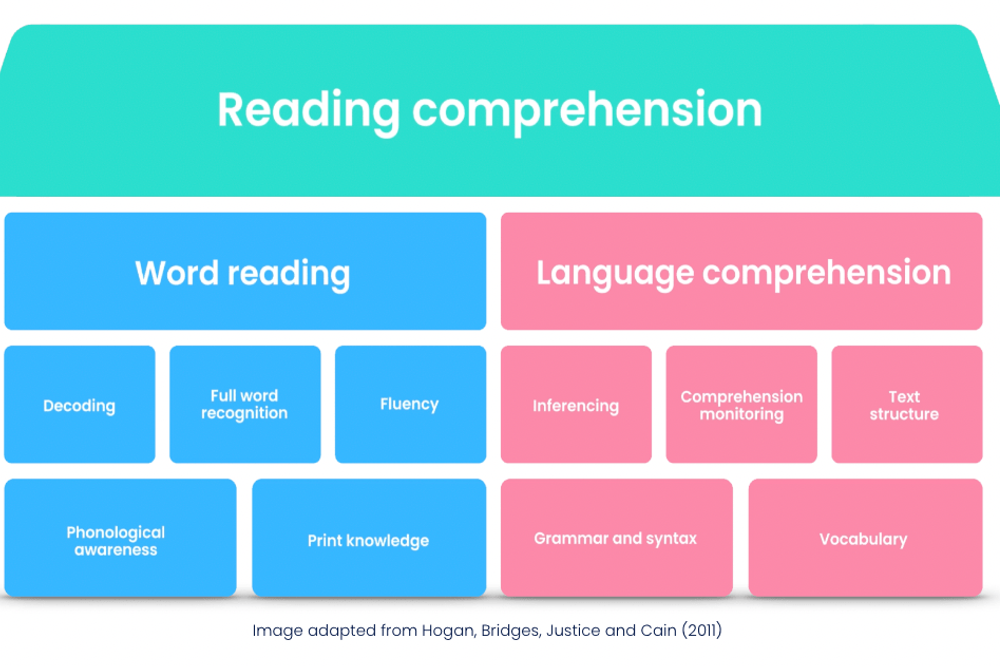What does it mean to read?
Williams (1984) argues that when we read, we’re not simply passive objects being fed with letters, words, and sentences. To arrive at global understanding, we work on a text by actively engaging with it and negotiating its meaning. This work requires us to bring our background knowledge and lived experiences to any reading task.

Activating schemata
The assumptions we make and the opinions we have are based on our individual experiences, as well as how our minds have organised any knowledge we gained from them (Nuttall, 2006). These experiences form a schema - a mental structure that is built upon all these past experiences, including information we have gained through learning and reading.
Reading requires us to process ideas in a text by drawing on what we call ‘our schemata.’ As individuals, we all have different opinions, backgrounds and experiences, so each of us has unique schemata. At the same time, we also have shared schemata - general beliefs and understandings of the world. When we connect our schemata with a writer’s, then we successfully understand a text.
Difficulties when reading
Learning to read goes beyond learning how to decode and understand the meaning of individual words; it involves knowing how to read for purpose, knowing how to interrogate a text, and being aware of the information we don’t know.
The demands of reading make it a challenging task for many learners. New readers may struggle with accessing a text because they find the code is difficult or there are too many unknown vocabulary items. For other readers, it might be that they have too little background knowledge on the subject they are reading about - cultural capital. To read a text meaningfully, we as readers need to share certain assumptions about the world and the way it works with the writer.
A three-phase approach to reading
In the classroom, reading can be best approached as a process broken down into three stages: pre-reading, while-reading, and post-reading. With this approach, the teacher makes use of learners’ knowledge of the world at the pre-reading stage and builds on this throughout the reading task (Nation, 1979). This has the effect of actively involving a learner with the reading task and encouraging them to read with intention.
One popular teaching method that adopts this three-phase approach to reading is the ‘KWL strategy’ - let’s look at this method in more detail.

Improve reading comprehension on Bedrock
Explicit vocabulary and grammar instruction with an individualised, self-marking curriculum.
What is the KWL strategy?
KWL stands for “Know, Want to know, and Learnt”. Sometimes, ‘W’ is substituted for Wonder. It is a framework for reading that was originally developed by Donna Ogle in the late eighties and was designed to be used when reading nonfiction texts in a group setting.
Underpinning the KWL strategy is the belief that readers gain knowledge by constructing meaning. A key principle of this approach to teaching reading is that meaning does not reside exclusively in text, but rather arises through negotiation between reader and writer. The KWL strategy incorporates the use of authentic texts and encourages learners to bring their personal experiences to their reading. It approaches reading as a top-down process and promotes skills such as making inferences and understanding words in context.
KWL reading printable template
To get started using the KWL reading method with your class, find our free PDF printable of the KWL template. With this, learners have everything they need to read new, ambitious texts deeply and curiously.
How to use a KWL chart to improve reading comprehension
The KWL strategy involves three basic cognitive steps:
- Learners access what they know
- Learners discover what they want to learn
- Learners recall what they learnt as a result of reading
To teach a lesson based on the KWL strategy, the teacher will need access to a whiteboard and should provide each learner with a worksheet that has three columns. Let’s now begin with step 1 – ‘Know.’
1. Step K - What I know
At the beginning of the lesson, the teacher activates learners’ schemata directly related to themes in the text and elicits any relevant vocabulary or ideas - activating prior knowledge. The pre-reading stage is the most important stage in the reading process because it limits the number of possibilities that students will infer whilst reading and encourages readers to read purposefully (Nuttall, 2005). Step K is organised into two levels.
The first level is teacher-led. During this step, learners create a mindmap of what they already know about the topic of the text, either individually or as a class on a whiteboard. The teacher guides learners by selecting and discussing key concepts relevant to the text. For example, if a text is about the food chain, a teacher may ask learners what they know about predators. The teacher should probe learners by asking how they know the information they have provided and where they read or heard it. Requiring learners to substantiate their claims challenges them to a higher level of thinking and encourages them to validate or invalidate information whilst reading.
During this initial stage, the teacher may identify that the learners have little background knowledge on the topic of the text, and therefore may need to scaffold their learning, asking more directed and specific questions or showing pictures to help them with visualising. At this stage, learners should be encouraged to ask questions and reflect on what they don’t know.
The second level of Step K involves thinking in categories of information. Learners should look at the information presented on the board and try to group it into categories as well as add further categories of information: for example, how something looks or where something lives. This activity should not be overlooked as it prepares learners for the next stage of KWL, which is Step W.
2. Step W – What do I want to learn?
At this stage, questions about what learners do not know or would like to know should have already started to emerge. There should be some categories listed on the board that are empty and indicate areas learners do not know about.
It is the teacher’s role here to highlight any disagreements or conflicting information and help learners notice gaps in the information they’ve provided; doing this will motivate and focus learners’ reading. This step is mostly carried out as a group; however, individual learners should also write down questions that they’re personally interested in discovering in the text.
3. Step L – What I learnt
Stage three, or Step L, can be completed either whilst reading or immediately after reading. This is usually dependent on the text. For example, when reading a longer text, the teacher may choose to reflect with learners section-by-section. However, most often, this step takes place post-reading.
Step L requires learners to write down what they’ve learnt. After learners have made their notes, attention should be brought back to the board to see if there are any questions that can now be answered or any empty categories where additional information can be added.
If there are some questions which haven’t been answered by the text, learners should be encouraged to conduct further reading. This is an opportunity to highlight to students that learning shouldn’t be framed around what an author chooses to include: instead it involves the pursuit of questions. Students learn to rely on reading as a method of acquiring further information and have the freedom to conduct their own research. When learners gain confidence doing this, the benefits of the KWL method for reading comprehension become multidisciplinary.
There are two important goals of the KWL method:
- Sparking curiosity
- Encouraging readers to take ownership of their learning
KWL Plus – an extension activity
The KWL method can be expanded to a four-step process known as ‘KWL plus,’ which incorporates an additional category: ‘What I still want to learn.’
At this stage, learners are given the opportunity to reflect on how they arrived at understanding and how they interacted with the text. This reflection can take place as a group discussion whereby students share with one another questions they asked themselves and the reading strategies they used, or through self-learning questionnaires. It’s important to make learners aware of the processes that underlie their reading and their effectiveness.
Benefits of using KWL charts to improve reading comprehension
Several studies have shown that materials taught using the KWL method have been better remembered and recalled. In addition to this, learners’ involvement with and enthusiasm for reading has been shown to improve, as well as their higher-order thinking skills. This is because the KWL method requires learners to organise information visually, which is more meaningful and apparent (Egan, 1999).
Furthermore, learners start to notice what is important when reading as the KWL strategy encourages them to pose questions at the pre-reading stage, supporting them to recognise that answering these questions in the post-reading stage requires them to rework their understanding until it’s satisfactory; this encourages learners to be intentional and critical in their reading.
The KWL method is an interactive activity that encourages learners to create, share, disagree, and respect one another’s opinions. Learners help one another activate prior knowledge, work together to construct new meanings, and value one another’s thinking. All this discovery and shared learning enhances a collaborative atmosphere in the classroom and promotes a mutual quest to seek new knowledge.
Four issues when using KWL charts
- Cross-cultural differences may limit a reader’s access to a text (Carrell, 1990). This can be a particular issue for learners with English as an Additional Language (EAL). Therefore, teachers should carefully select texts that will be accessible to their learners and ensure that students have enough background knowledge to access the content, providing targeted scaffolding where necessary. It is crucial that the teacher elicits what learners know at the pre-reading stage because this can indicate whether a text will be appropriate for a group or an individual.
- Teachers should be mindful of technical vocabulary or unknown abbreviations in a text and whether these might prove too challenging for readers - to combat this, pre-teach ambitious vocabulary that learners should know in order to comprehend the text.
- At Step K, learners may not be able to think of more categories of information. This is often an indicator that a group is not ready for this level of thinking and may need to do more background reading and learning on the subject before reading about it.
- Sometimes a learner may have a different perspective on a text and notice things that the teacher possibly overlooked, or a learner may arrive at a different interpretation because of their lived experience. In this case, it’s important to remember that the teacher’s role is not to expect everyone to agree with a text, but to help readers see the meaning intended by the writer. It’s good practice to hold space in the classroom for critical discussions and not simply deny the importance of personal responses. However, teachers should emphasise that “to be entitled to disagree with a text, we must first understand it.” (Nuttall, 2005)
Ultimate goals of reading
According to Williams (1984) the goals we should be working towards in the classroom are:
- Providing learners with the skills needed to read with comprehension
- Helping learners read flexibly and according to purpose
- Ensuring learners learn language and content from reading (while-reading)
- Promoting reading with some degree of critical awareness
The KWL strategy successfully nurtures all of these skills in an interactive, engaging way that is both easy for the teacher to prepare and deliver and fun for learners to participate in.
Ways Bedrock’s digital literacy curriculum supports KWL reading in lessons
While the KWL approach has the most benefits when accompanied by scaffolding and instruction in the classroom - after all, it is guided by insightful conversations between learners and teachers - Bedrock’s literacy improvement features work alongside a KWL strategy to support learners’ reading comprehension.
Pre-teaching vocabulary
Sequencing your bespoke vocabulary curriculum on Bedrock Mapper gives teachers of every subject the ability to pre-teach vocabulary learners need to access academic texts. One of the main barriers to the KWL reading method is learners lacking the prior knowledge of content and vocabulary to comprehend the contents of a text.
With Mapper, teachers can add vocabulary, complete with examples and contextual definitions, to their unique lesson plan. When sequenced correctly (and this is made easy with Mapper), vocabulary is taught alongside in-class teaching to provide learners with the contextual knowledge they need to make the most of the KWL method.
Vocabulary and grammar instruction
For a learner to be able to access a text, they must have strong prior knowledge of its construction - this includes grammar and vocabulary knowledge.
Teachers can spend more time focusing on the benefits of KWL reading for deep reading comprehension when vocabulary and grammar knowledge is secure. As demonstrated in the Reading House, comprehension is just one pillar of effective reading, with the others supported by fundamental literacy skills.
To provide holistic reading instruction, KWL reading in class can be accompanied by vocabulary and grammar instruction at home - this is made simple with Bedrock’s digital literacy curriculum.




